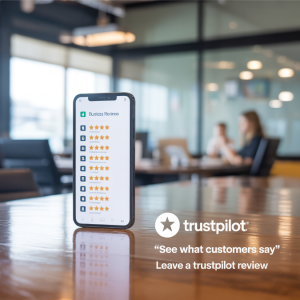In the digital age, reputation is everything. Whether you’re buying a coffee machine or selecting a financial advisor, chances are you’ll glance at customer reviews before making a decision. Among the sea of review platforms, Trustpilot reviews have emerged as a leading source of truth for consumers and a powerful tool for businesses.
But how effective is Trustpilot really? Can a single review truly influence a company’s credibility? And how might companies morally make use of this platform? This blog dives deep into the Trustpilot Business Reviews Service, revealing why it’s more than just a review site—it’s a reputation engine.

What Is Trustpilot?
Trustpilot is an open review platform where consumers can leave feedback on businesses across various industries. Founded in 2007 in Denmark, the platform has grown to host over 167 million reviews for 714,000+ domains globally. Unlike some closed platforms, Trustpilot allows anyone to leave a review, making it highly transparent—and at times, controversial.
Key Features:
- Verified and unverified review capabilities
- Business account dashboards
- Review response tools
- TrustBoxes (review widgets for websites)
- SEO integration features
Whether you’re a small e-commerce store or a multinational brand, Trustpilot offers tools to manage and respond to customer feedback in real-time.
Why Do Trustpilot Reviews Matter?
A Trustpilot review carries more weight than just a star rating. Here’s why it’s critical to pay attention:
1. Social Proof That Converts
A BrightLocal survey indicates that 84% of buyers rely just as much on online reviews as on personal recommendations. A high Trustpilot rating can directly influence purchasing behavior.
2. SEO Advantages
Trustpilot pages rank well in Google search results. By integrating Trustpilot reviews into your site, you can enhance keyword visibility and organic traffic.
3. Customer Engagement
Trustpilot offers a two-way communication channel. Businesses can respond to negative reviews, address concerns, and publicly demonstrate customer care.
4. Reputation Management
Trustpilot gives businesses insights into common issues and recurring feedback themes. It’s a built-in focus group that helps shape better customer experiences.
5. Transparency & Trust
Because anyone can leave a review, it builds a sense of authenticity. This openness fosters stronger consumer trust—though it also opens doors for fake reviews, a challenge we’ll address later.
Trustpilot vs. Other Review Platforms
| Feature | Trustpilot | Google Reviews | Yelp | SiteJabber |
| Global Reach | Very High | Very High | Medium | Medium |
| Free Business Account | Yes | Yes | Yes | Yes |
| Paid Features | Review invitations, Ads, Widgets | Google Ads | Yelp Ads | Analytics |
| Consumer Transparency | Open platform | Semi-open | Moderated heavily | Semi-open |
| SEO Value | High | Very High | Moderate | Moderate |
| Review Moderation | Flag & Appeal | Report only | Yelp filters reviews | Community reporting |
Insight: Trustpilot strikes a balance between open consumer expression and tools for businesses to monitor feedback. While Google Reviews offer better visibility, Trustpilot provides a more interactive ecosystem.

How to Leave a Trustpilot Review (Step-by-Step)
Leaving a Trustpilot review is simple, but a well-written one can make a meaningful impact:
Step 1: Visit the Business Profile
Search for the business name on Trustpilot.
Step 2: Click “Write a Review”
On the company’s page, click the green “Write a Review” button.
Step 3: Share Your Experience
Provide a title, write about your experience, and rate the business from 1 to 5 stars. Try to be specific—mention product quality, customer service, or delivery time.
Step 4: Submit
You must register with Trustpilot or log in using Google or Facebook. This helps verify authenticity.
Pro Tip: Include constructive feedback. Honest and respectful reviews foster real improvement.
Common Issues: Fake Reviews and Business Manipulation
While Trustpilot is a powerful tool, it’s not without flaws. The platform has faced criticism over:
- Fake Reviews: Some companies hire third parties to flood their pages with positive reviews.
- Review Bombing: Sometimes companies utilize the declining feature to eliminate legitimate bad reviews.
- Flagging Abuse: Businesses sometimes misuse the flagging tool to remove valid negative reviews.
Trustpilot has implemented AI and manual review teams to detect anomalies, but vigilance is required from both users and businesses.
Best Practices for Businesses Using Trustpilot
Whether you’re just getting started or trying to improve your profile, follow these tips:
1. Actively Request Reviews
Send follow-up emails after purchases asking for feedback. Trustpilot even provides automated tools for this.
2. Respond to All Reviews
Yes—even the bad ones. A thoughtful reply shows commitment and professionalism.
3. Display TrustBoxes on Your Website
These are widgets that showcase your reviews directly on your site. Great for social proof.
4. Use Reviews for Business Improvement
Treat your reviews as free market research. Analyze the feedback and adjust your services accordingly.
5. Stay Ethical
Avoid incentivizing reviews or hiring agencies to post fake ones. Trustpilot has strict rules and penalties.
Real-World Insight: My Personal Experience
As a digital marketing consultant, I’ve worked with over 50 businesses trying to build a reputation online. One of my clients—a mid-sized eCommerce brand—had zero presence on Trustpilot. After integrating review requests into their post-purchase emails, they accumulated over 300 reviews in six months.
Result?
- 22% rise in conversion rates on embedded review-containing product pages
- Higher click-through rates from Google due to rich snippets
- Improved customer trust through public interaction on negative reviews
It proved what we already suspected: Trustpilot reviews aren’t optional—they’re essential.
Leveraging Trustpilot for SEO & Credibility
Beyond visibility, Trustpilot has specific SEO perks:
Schema Markup: Review widgets can activate search results’ star ratings.
Keyword Integration: Review content often includes long-tail keywords naturally used by customers.
Domain Authority: Trustpilot’s domain itself ranks well, helping even newer businesses get noticed.
To maximize these benefits, integrate Trustpilot reviews into landing pages, emails, and your Google Business Profile.
Trustpilot Business Subscription: Is It Worth It?
While Trustpilot provides a free account, paying plans enable premium capabilities:
Key Benefits:
- Automated review invites
- Custom TrustBoxes
- Review analytics and insights
- Google Seller Ratings integration
Verdict: For growing businesses or those in competitive niches, the premium plan is worth considering.
Conclusion: Trustpilot Reviews as a Growth Engine
In a world where trust is currency, Trustpilot reviews offer a transparent, scalable way to build credibility. From improving SEO to gathering customer insights, this platform is more than a digital suggestion box—it’s a dynamic reputation builder.
Whether you’re a consumer looking to share your experience or a business aiming to win hearts (and wallets), Trustpilot offers the tools to make your voice count.
Call-to-Action
Have you used Trustpilot to share your experience or grow your brand? Comment below; we would be very interested in your story.
Want more actionable insights like this? Subscribe to our newsletter or check out our deep dive on Google Business Reviews vs. Trustpilot!






